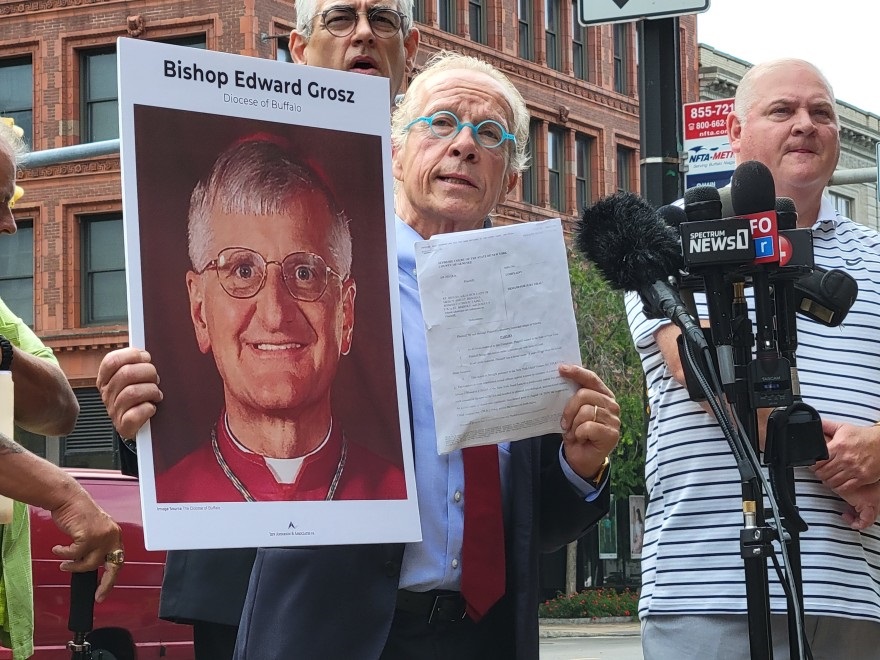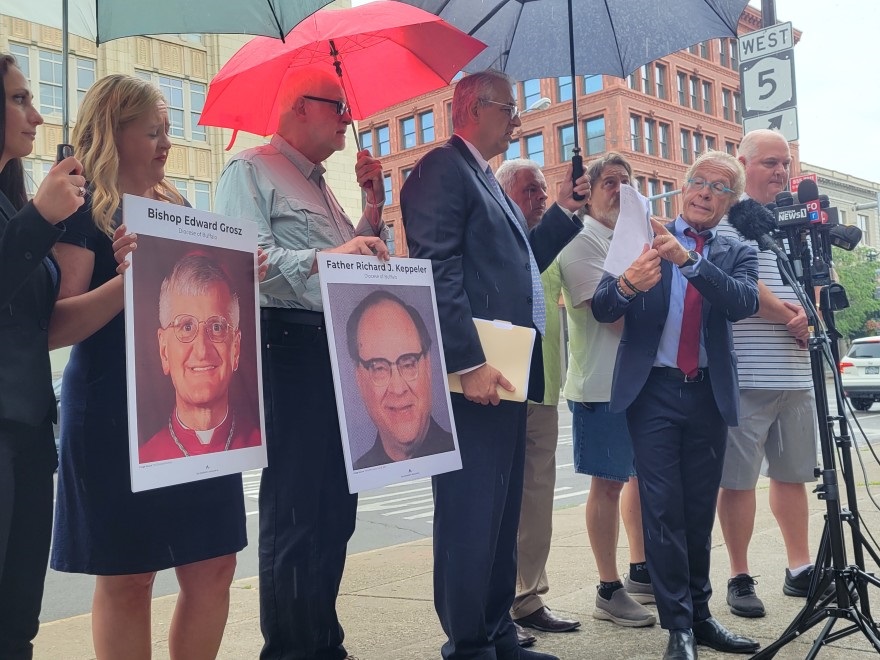BUFFALO (NY)
WBFO [Buffalo NY]
July 14, 2021
By Tom Dinki
A plaintiff in a Child Victims Act lawsuit says he attended his 1990 confirmation ceremony in a Genesee County church planning to tell Buffalo Auxiliary Bishop Edward Grosz he was being abused by another priest.
Instead, the plaintiff says, Grosz made comments about his good looks and repeatedly groped him.
Attorneys for the alleged victim stood outside the Catholic Diocese of Buffalo headquarters Tuesday and revealed new details of the abuse allegation against Grosz, the former second-in-command of the Buffalo Diocese who was responsible for handling sexual abuse allegations against priests.
“[The victim] was raised Catholic, he was well aware of the impact of naming a bishop, but this is his truth,” said attorney Steve Boyd.
Boyd and other attorneys filed a lawsuit Monday in New York State Supreme Court, alleging their client, who is unnamed in court papers, was abused as a teenager by Grosz and another priest, the Rev. Richard Keppeler.
Grosz retired last year but has continued to do limited sacramental ministries. He has voluntarily stepped down from those roles pending an investigation, but denies ever abusing anyone, the Buffalo Diocese said Monday. Keepeler was removed from ministry in 2003 over abuse allegations and died in 2011.
The complaint alleges Keppeler abused the victim from approximately 1985 to 1990 when the victim was 10 to 15 years old. At the time, Keppeler was a priest at St. Brigid Church in Bergen.
The victim decided to inform Grosz of Keppeler’s abuse at a confirmation ceremony at St. Brigid’s in 1990, attorneys said Tuesday. However, the victim never told Grosz because of a comment Grosz made to Keppeler during the ceremony.
“As [the victim] walked up to make his confirmation, a sacrament, Bishop Grosz was heard to say to Keppeler, Oh, Dick, you were right about this one. He looks like he could be in GQ magazine,’” Boyd said. “[The victim] realized almost immediately that the bishop was just like Keppeler.”
Then, at a gathering at the church following the ceremony, Grosz allegedy repeatedly groped the victim.
“[The victim] went to the confirmation thinking, ‘This is my chance to tell the bishop, this is my chance to blow [Keppeler] in and to get him taken away,” Boyd said, “and [the victim] was betrayed by the bishop.”
And he is far from the only victim that Grosz betrayed, said another attorney for the victim, Jeff Anderson. The state Attorney General’s Office last year filed a lawsuit accusing Grosz, as well as former Buffalo Bishop Richard Malone, of failing to report over two dozen priests to the Vatican.
“[Grosz] was the bishop that was supposed to be handling this issue,” Anderson said. “And he is the bishop that has not only betrayed this survivor by exploiting and assaulting him, but he betrayed so many survivors for so long by being a part of the concealment.”

Michael Whalen, whose allegation against the Rev. Norbert Orsolits in 2018 sparked the Buffalo Diocese abuse scandal, said Tuesday he told Grosz about the abuse about a year before he went public.
“Bishop Grosz told me that the statute of limitations had come and gone and that there was nothing that I could do. He offered me counseling, but I was already going to counseling,” Whalen said. “But he never apologized.”
Since Whalen came forward, the Diocese has acknowledged more than 100 of its priests as being credibly accused of abuse. Nine are currently on leave pending investigations.
Boyd read aloud a statement from the alleged victim in the Grosz case.

“My family has been aware of the inappropriate contact with Bishop Grosz since it happened 31 years ago. I first told my mother the full extent of that interaction 13 years ago,” the statement read. “I am ready now with the support of my family and my attorneys to let the legal process run its course.”
The victim started thinking about coming forward in December 2019 after taking offense to a comment made by Malone regarding survivors.
“He found it to be unfeeling and uncaring, and he knew what had happened to him and it triggered him,” Boyd said.
Abuse survivors are often asked why they’re coming forward after so many years.
“When a child is abused by a revered authority figure … they suffer in silence in secrecy and shame,” Anderson said. “And that’s why the law and the legislature open this window for survivors to actually have their truth known because they always lived in fear of not being believed and blaming themselves.”
The extended window to file Child Victims Act lawsuits ends Aug. 13.
